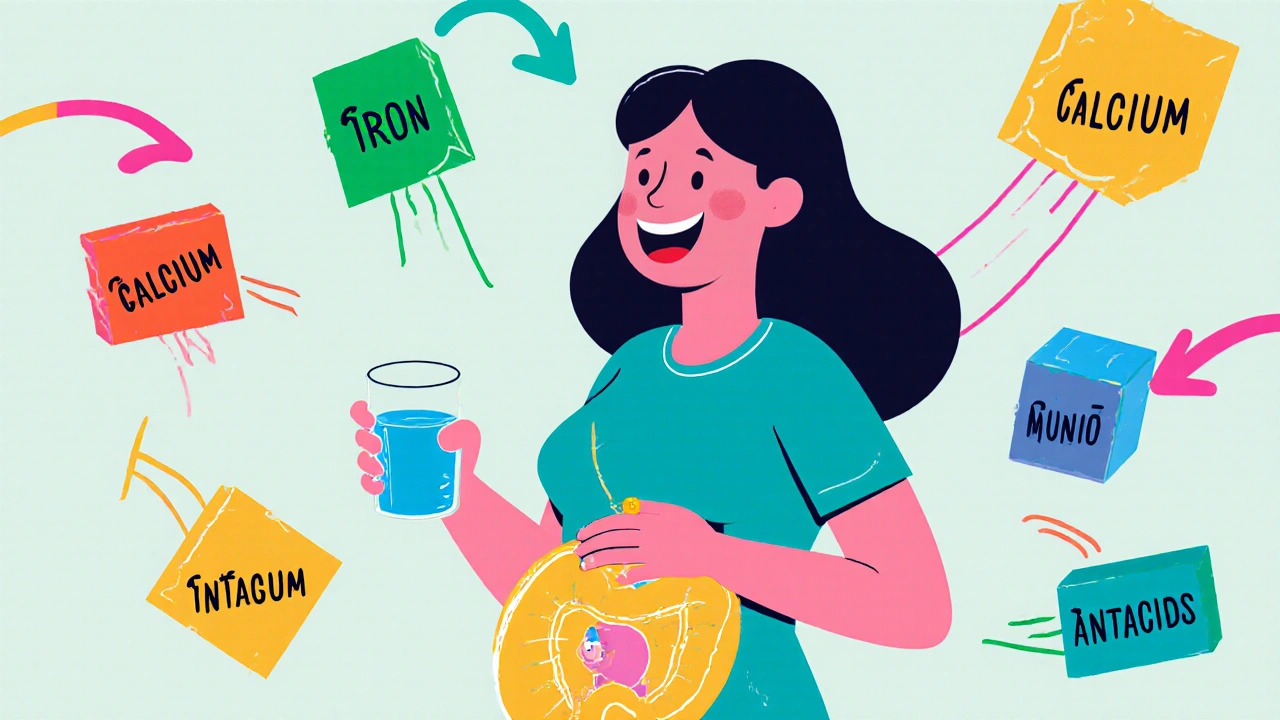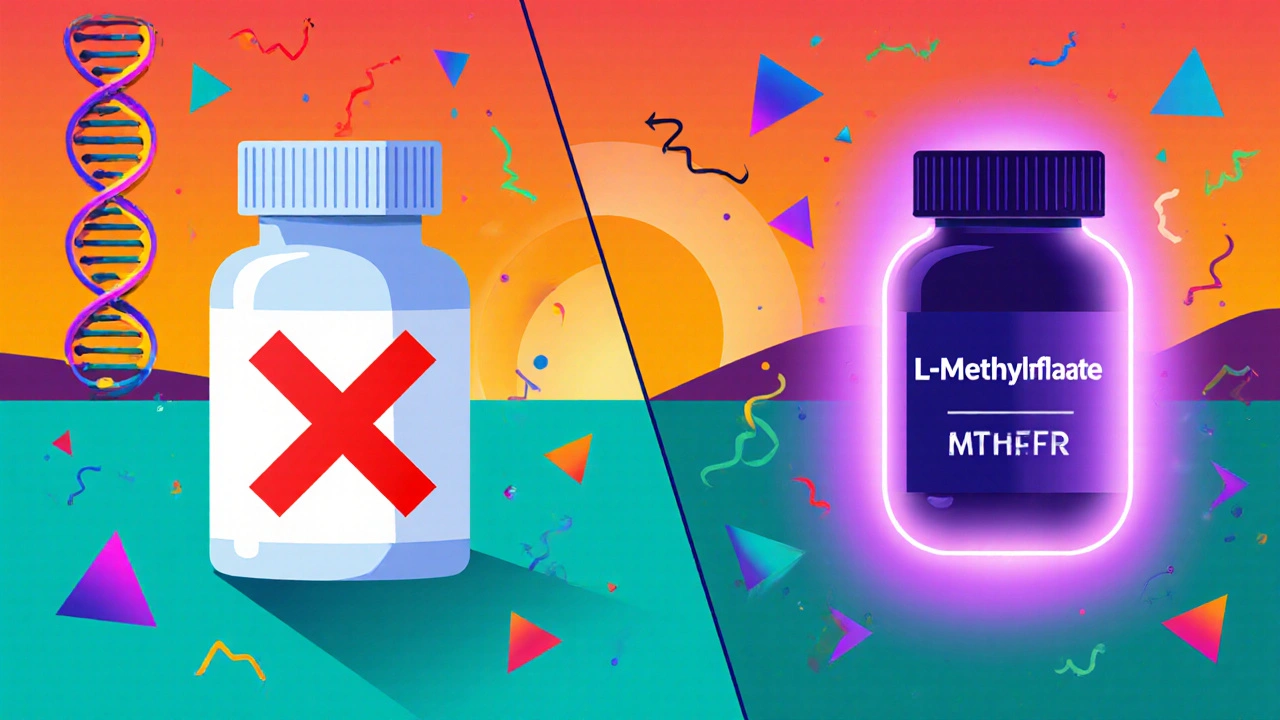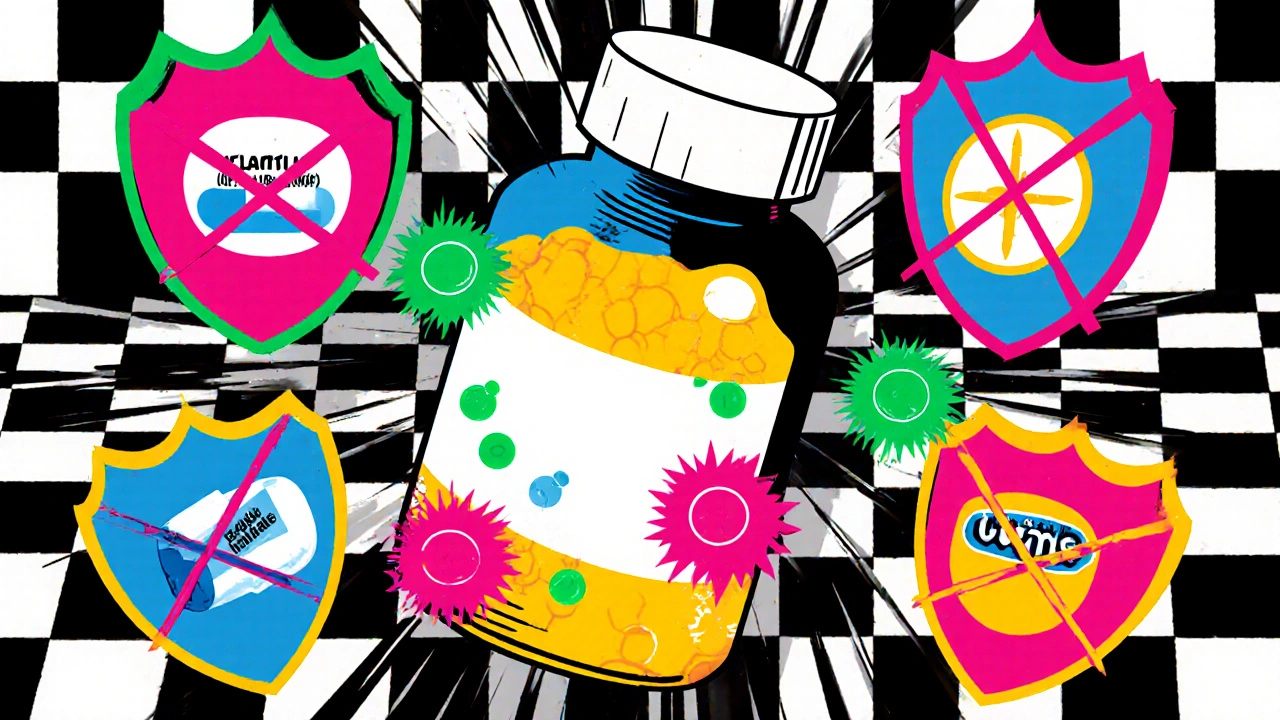When you're pregnant, taking folic acid isn't just a suggestion-it's one of the most important steps you can take to protect your baby's development. But here's something most people don't realize: folic acid doesn't play nice with every medication. What seems like a simple supplement can interfere with drugs you're already taking, sometimes in dangerous ways.
Why Folic Acid Matters So Much
Folic acid, the synthetic form of vitamin B9, is the reason neural tube defects like spina bifida and anencephaly have dropped by nearly half since the 1990s. The CDC recommends 400 micrograms (mcg) daily for anyone who could become pregnant-not just those actively trying. Why? Because the neural tube closes between 21 and 28 days after conception, often before a woman even knows she’s pregnant.
During pregnancy, your body needs 600 mcg of folate daily. Most prenatal vitamins contain 600 to 1,000 mcg of folic acid. That’s because synthetic folic acid is absorbed better than natural folate from food-up to 100% from supplements, compared to just 50% from spinach or beans. Fortified foods like bread and pasta add another 140 mcg per 100 grams, which helps millions of women meet their needs without even thinking about it.
How Medications Can Fight Against Folic Acid
Some medications work by blocking folate metabolism. When you take folic acid with them, it can reduce the drug’s effectiveness-or make you more vulnerable to side effects.
- Anticonvulsants like phenytoin (Dilantin), carbamazepine (Tegretol), and valproic acid are designed to slow brain activity. But folic acid can interfere with how they work. There are documented cases of women with epilepsy having breakthrough seizures after starting prenatal vitamins. If you’re on one of these drugs, your doctor might prescribe 4,000-5,000 mcg of folic acid daily-far above the standard dose.
- Methotrexate, used for autoimmune diseases and sometimes for ectopic pregnancies, is a folate antagonist. It kills rapidly dividing cells. Folic acid can help reduce its toxicity without making it less effective, but only if dosed correctly under medical supervision. Never mix these without your provider’s guidance.
- Pyrimethamine, used to treat toxoplasmosis during pregnancy, works by blocking folate in parasites. Adding folic acid can make it less effective. Pharmacists report that 32% of pregnant women on this drug need their doses adjusted when starting supplements.
- Sulfasalazine, used for ulcerative colitis and rheumatoid arthritis, reduces folic acid absorption by up to 60%. The UK’s NICE guidelines warn against taking them together without medical oversight.
- Cholestyramine and antacids (like Tums or Pepcid) can lower folic acid absorption by 25-50%. If you take these for heartburn or high cholesterol, space them out by at least two hours from your folic acid.
Iron and Calcium: The Silent Interferers
You might think iron and calcium are just helpful additions to your prenatal. But they can quietly mess with folic acid.
Research from the American Journal of Clinical Nutrition shows iron can reduce folic acid absorption by 20-30% when taken at the same time. That’s why many women feel nauseous with their prenatal-they’re getting a heavy iron punch all at once. The fix? Take your prenatal with breakfast and your iron supplement at bedtime, or switch to a prenatal with less iron and take a separate iron pill.
Calcium-rich foods-milk, yogurt, cheese, fortified plant milks-can cut folic acid absorption by 25%. If you drink a glass of milk with your vitamin, you’re losing ground. Take your folic acid on an empty stomach with water, at least 30 minutes before eating.
Who Needs More Than the Standard Dose?
Not everyone needs the same amount. Your risk factors determine your dose.
- If you’ve had a previous pregnancy affected by a neural tube defect, your doctor will likely recommend 4,000 mcg daily, starting at least one month before conception.
- If you have diabetes, obesity, or are on dialysis, your body may process folate differently. Higher doses (up to 1,000 mcg) are often advised.
- If you carry the MTHFR 677C>T gene variant (common in 10-25% of people, especially Hispanics), your body struggles to convert folic acid into its active form. In these cases, L-methylfolate (like Quatrefolic®) is a better choice. The FDA approved the first prenatal with this form in 2023.
- Women taking HIV medications like efavirenz may need extra folic acid because the drugs interfere with folate metabolism.

What About Side Effects?
Some people worry about too much folic acid. Is it hiding a vitamin B12 deficiency? The old fear was that folic acid could mask symptoms of pernicious anemia-like fatigue and tingling-while letting nerve damage worsen. But modern research shows that’s not a real concern at recommended doses. The CDC and Mayo Clinic agree: if you’re getting enough B12 (which prenatal vitamins usually include), folic acid won’t hide the problem.
What about unmetabolized folic acid floating in your blood? Some researchers, like Dr. Joseph Selhub from Tufts, worry it could build up with doses over 1,000 mcg daily. But the CDC says there’s no confirmed harm from this. The upper limit is set at 1,000 mcg for adults-not because it’s dangerous, but because we don’t yet know what long-term excess might do.
Real-world reports from Reddit and BabyCenter show many women switch to standalone folic acid (400-800 mcg) and take iron separately because the combo makes them sick. That’s smart. You don’t need to swallow a giant pill just to meet your needs.
What About Autism Risk?
There’s conflicting data here. A 2022 study of 45,300 children in the U.S. found a 40% lower risk of autism spectrum disorder (ASD) in kids whose mothers took folic acid before and during early pregnancy. But a 2021 Danish study of 35,000 children found no link. Why the difference? Maybe genetics, diet, or how the supplements were taken. The NIH is now prioritizing this question in its 2024 research agenda.
For now, the benefit for neural tube defects is rock-solid. The possible link to reduced ASD risk is promising but still being studied. Don’t skip folic acid hoping to avoid autism-it’s not that simple.
How to Take It Right
Here’s the simple plan:
- Start 400 mcg of folic acid at least one month before trying to conceive.
- Continue through the first trimester (at least 12 weeks). Some experts recommend continuing the full term.
- Take it on an empty stomach with water-30 minutes before breakfast works best.
- Avoid taking it with antacids, calcium-rich meals, or iron supplements at the same time.
- If you’re on any prescription meds, talk to your doctor or pharmacist before starting any new supplement.
- If you’re on anticonvulsants, MTHFR variant, or have had a prior NTD pregnancy, ask about higher doses or L-methylfolate.

What to Look for in a Prenatal
Not all prenatal vitamins are equal. Here’s what to check:
- Folic acid content: 600-1,000 mcg is standard. Prescription versions may go higher.
- Form: If you have MTHFR, look for L-methylfolate (Quatrefolic®, Metafolin®). It’s more expensive but better absorbed.
- Iron: If you’re prone to nausea, choose one with lower iron (17-27 mg) and take extra iron separately.
- Third-party testing: Look for USP or ConsumerLab verification. A 2020 test found 12 of 15 prenatal vitamins met heavy metal safety standards.
- Price: CVS Health Prenatal costs $8.99/month. Thorne Basic Prenatal runs $38.99. You don’t need the priciest one-but avoid the cheapest ones without testing.
What If You Forgot?
If you didn’t start before pregnancy, don’t panic. Start now. Even if you’re 8 weeks along, taking folic acid still helps with your baby’s brain and spinal cord development. It’s not too late.
And if you’re breastfeeding? Keep taking it. Folate is passed through breast milk, and your body still needs it to recover and produce milk.
Can I get enough folic acid from food alone?
No. Even with a diet rich in leafy greens, beans, and fortified grains, most women don’t get 600 mcg daily. Fortified foods help, but they’re not enough on their own. Supplements are necessary to reach the levels proven to prevent neural tube defects.
Is it safe to take folic acid with my prenatal vitamin if I’m also on antidepressants?
Most antidepressants, including SSRIs like sertraline and fluoxetine, don’t interact with folic acid. But if you’re taking a drug like methotrexate for an autoimmune condition, that’s different. Always check with your doctor before combining any supplement with prescription meds.
What’s the difference between folic acid and methylfolate?
Folic acid is synthetic and must be converted by your body into the active form, L-methylfolate. Some people-especially those with the MTHFR gene variant-can’t do this efficiently. Methylfolate supplements skip that step and are ready to use. If you’ve had trouble with standard prenatal vitamins, methylfolate may be easier on your system.
Can folic acid cause miscarriage?
No. There’s no credible evidence linking folic acid to miscarriage. In fact, low folate levels are linked to higher miscarriage risk. The CDC, ACOG, and WHO all confirm folic acid supplementation reduces the risk of early pregnancy loss by supporting healthy cell division.
Should I stop folic acid after the first trimester?
Not necessarily. While the neural tube closes by week 12, your baby’s brain and spinal cord keep developing. Folic acid also supports red blood cell production and placental growth. Most experts recommend continuing through pregnancy and breastfeeding.
Final Takeaway
Folic acid is one of the most powerful tools in prenatal care. But it’s not a one-size-fits-all supplement. Your medications, genetics, diet, and health history all change what you need. Talk to your doctor. Don’t assume your prenatal vitamin is enough. And never start or stop anything without checking for interactions. Your baby’s development depends on getting it right-not just taking it.


